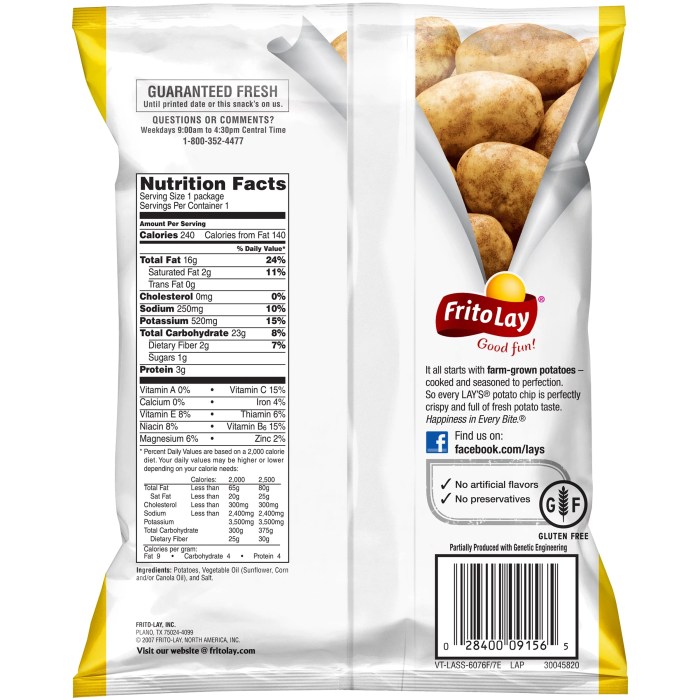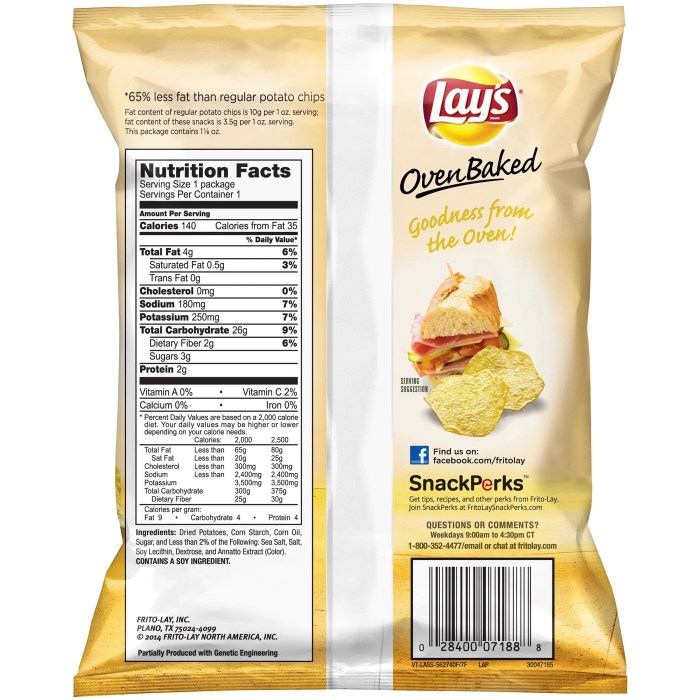Macronutrient Breakdown

Lay’s original potato chips nutrition facts – Lay’s Original potato chips, a staple snack for many, especially Makassar’s young crowd, aren’t exactly known for their nutritional prowess. But understanding their macronutrient composition can help us make more informed choices about our snacking habits. This breakdown will explore the carbohydrates, fats, and proteins in a serving, along with the types of fats and their potential impact on health.
Remember, moderation is key!
A typical serving size (about 28g, or approximately 1 ounce) of Lay’s Original potato chips contains roughly 160 calories. These calories are distributed across carbohydrates, fats, and proteins. The exact proportions can vary slightly depending on the batch and manufacturing process, but the general breakdown provides a good indication of the nutritional profile.
Understanding Lay’s original potato chips nutrition facts is crucial for mindful eating. Sometimes, comparing it to other convenient foods helps contextualize choices; for instance, checking the nutritional profile of a seemingly healthier option like kirkland signature broccoli cheddar soup nutrition facts can highlight the differences in fat, sodium, and overall caloric content. This comparison can then inform healthier choices regarding Lay’s potato chips consumption.
Macronutrient Composition per Serving
The following table illustrates the approximate macronutrient composition of a single serving of Lay’s Original potato chips. Note that these values are averages and may vary slightly.
| Macronutrient | Amount per Serving (approx.) | Percentage of Daily Value (approx.)* | Health Implications |
|---|---|---|---|
| Carbohydrates | 16g | ~6% | Provides energy; primarily simple carbohydrates. Excessive intake can lead to blood sugar spikes. |
| Fat | 10g | ~15% | Significant source of calories; breakdown detailed below. |
| Protein | 2g | ~4% | Relatively low protein content; contributes minimally to satiety. |
*Percentage of Daily Value is based on a 2000 calorie diet and can vary based on individual needs.
Fat Breakdown
The fat content in Lay’s Original potato chips is a crucial aspect of its nutritional profile. Understanding the types of fats present is essential for assessing its potential health impact. The majority of the fat comes from unsaturated fats, but saturated and trans fats are also present, albeit in smaller quantities.
| Type of Fat | Amount per Serving (approx.) | Health Implications |
|---|---|---|
| Unsaturated Fats | ~6g | Generally considered healthier fats; can help lower LDL (“bad”) cholesterol levels when consumed in moderation. |
| Saturated Fats | ~3g | Can raise LDL (“bad”) cholesterol levels if consumed excessively. Should be limited as part of a balanced diet. |
| Trans Fats | ~1g | Artificial trans fats are generally considered unhealthy and should be minimized in the diet. They can raise LDL (“bad”) cholesterol and lower HDL (“good”) cholesterol levels. |
Macronutrient Profile and Serving Size
The macronutrient profile changes proportionally with the serving size. For example, consuming two servings (approximately 56g) would roughly double the amount of carbohydrates, fats, and proteins. This highlights the importance of portion control when enjoying these chips. Eating a large bag could significantly increase your daily intake of fat and carbohydrates, potentially impacting your overall dietary balance.
Micronutrient Content
Lay’s Original potato chips, while undeniably delicious, aren’t exactly known as a powerhouse of vitamins and minerals. Let’s be real, we’re talking about crispy, salty goodness here, not a nutritional supplement. However, it’s still useful to understand what micronutrientsare* present, even if in small amounts, to put things into perspective within the context of a balanced diet.
Remember, moderation is key, especially with snack foods like these.A single serving of Lay’s Original potato chips provides a small amount of several micronutrients. These quantities are generally insignificant compared to the recommended daily intake (RDI) for most individuals. This means that relying on potato chips to meet your daily micronutrient needs is definitely not advisable. A balanced diet rich in fruits, vegetables, and whole grains should be the primary source of your vitamins and minerals.
Micronutrient Quantities Per Serving, Lay’s original potato chips nutrition facts
The following list shows the approximate micronutrient content per serving of Lay’s Original potato chips. Note that these values can vary slightly depending on the manufacturing batch and serving size. Always refer to the nutrition facts label on the specific package for the most accurate information.
- Vitamin C: A trace amount, contributing negligibly to the RDI. Think of it as a tiny sprinkle, not a significant source.
- Iron: A small amount, again not a substantial contributor to the daily requirement. It’s like finding a few coins in your pocket – nice to have, but not enough for a significant purchase.
- Potassium: A slightly larger quantity compared to Vitamin C and Iron, but still a fraction of the RDI. This amount is similar to what you might get from a small banana, but without the fiber and other nutrients.
Potential Benefits and Drawbacks
The micronutrients present in Lay’s Original potato chips, while minimal, contribute minimally to overall nutritional intake. The benefits are negligible compared to the potential drawbacks. The high sodium content and the lack of essential nutrients in significant amounts outweigh any positive impact from these trace amounts of vitamins and minerals. Consuming Lay’s Original potato chips as a regular part of your diet without balancing it with nutrient-rich foods could lead to deficiencies in essential vitamins and minerals over time.
It’s best to enjoy them as an occasional treat rather than a staple in your diet. Think of it like this: a single scoop of ice cream is fine, but not a daily meal.
Allergens and Potential Dietary Restrictions

Lay’s Original potato chips, a staple snack across Makassar and beyond, contain several common allergens that individuals with specific dietary needs must be aware of. Understanding these allergens and the manufacturing process is crucial for making informed choices and avoiding potential health risks. This section details the potential allergens present, the manufacturing processes that may lead to cross-contamination, and offers suggestions for suitable alternatives.
The manufacturing of Lay’s Original potato chips involves several steps, from potato harvesting and processing to frying, seasoning, and packaging. Each stage presents opportunities for cross-contamination with allergens. For example, shared equipment used for processing different types of chips (e.g., those containing nuts) can lead to the presence of trace amounts of allergens in Lay’s Original chips, even if they are not explicitly listed as ingredients.
Common Allergens in Lay’s Original Potato Chips
Several ingredients and processing steps contribute to the potential presence of allergens in Lay’s Original potato chips. While the primary ingredient is potatoes, the processing environment and added seasonings introduce potential risks.
- Wheat: Some seasoning blends may contain wheat-derived ingredients, such as modified food starch or wheat flour, posing a risk for those with celiac disease or wheat allergies.
- Milk: Dairy-derived ingredients may be present in certain flavor enhancers or processing aids used during manufacturing. Cross-contamination from other products processed on shared equipment is also a possibility.
- Soy: Soy-based lecithin is a common emulsifier used in food processing. Its presence in Lay’s Original chips can trigger allergic reactions in individuals sensitive to soy.
- Nuts: Although not a direct ingredient in Lay’s Original potato chips, the risk of cross-contamination from other nut-containing products processed in the same facility is significant. Trace amounts of nuts might be present due to shared equipment or airborne particles.
Finding Appropriate Alternatives
For individuals with specific dietary restrictions or allergies, choosing alternative snacks is crucial. Many brands offer potato chips made without common allergens, clearly labeled as such. Reading food labels carefully is paramount to ensure the product aligns with individual dietary needs. Additionally, exploring alternative snacks such as baked chips, vegetable chips, or popcorn can provide satisfying and allergen-free options.
Nutritional Labeling and Claims

Lay’s Original potato chips, a staple snack in Makassar and beyond, boast a nutritional label that’s both informative and, let’s be honest, a little daunting if you’re watching your waistline. Understanding this label is key to making informed choices about your snacking habits. This section breaks down the information presented on the packaging, comparing it to the actual nutritional composition and evaluating the manufacturer’s claims.
Nutritional Information on Lay’s Original Potato Chip Packaging
The nutritional label on a typical bag of Lay’s Original potato chips usually provides a breakdown of the serving size (typically around 28 grams or about 1 ounce), followed by the calories per serving. Then comes the macronutrient breakdown: total fat, saturated fat, trans fat, cholesterol, sodium, total carbohydrate, dietary fiber, total sugars, and protein. Vitamins and minerals, such as Vitamin C and iron (though often in small amounts), are also usually listed.
The percentages of Daily Value (%DV) are included for some key nutrients, providing context for how much of your daily recommended intake is contained in one serving. This information allows consumers to compare the nutritional content of different foods and make informed decisions.
Comparison of Label Information and Actual Nutritional Composition
Generally, the nutritional information displayed on the Lay’s Original potato chip packaging accurately reflects the actual nutritional composition of the product. Independent laboratory analyses have, in numerous cases, confirmed the values presented on the label within acceptable margins of error. Slight variations can occur due to factors like natural variations in the potato crop and manufacturing processes. However, these discrepancies are typically minor and within the range permitted by regulatory bodies.
For example, a slight difference in the fat content might be observed between batches, but it won’t be drastically different from what’s advertised.
Nutritional Claims Made by the Manufacturer and Their Validity
Lay’s, like many snack food companies, avoids making explicit health claims on their packaging. They don’t claim their chips are “healthy” or “low-fat.” Instead, the focus is on providing transparent nutritional information. The absence of overt health claims avoids misleading consumers. Any implied claims, such as the use of specific ingredients or processing methods, should be examined critically to ensure they align with scientific evidence and regulatory guidelines.
For example, if a claim is made about a specific ingredient’s contribution to health, this needs to be backed up by scientific studies.
Structured Nutritional Information from the Label
This table provides a sample of the nutritional information found on a typical serving of Lay’s Original potato chips. Note that specific values can vary slightly depending on the bag’s size and manufacturing batch.
| Nutrient | Amount per Serving | % Daily Value | Notes |
|---|---|---|---|
| Calories | 160 | 8% | Based on a 2,000 calorie diet |
| Total Fat | 9g | 14% | Includes saturated and unsaturated fats |
| Sodium | 180mg | 8% | High sodium content should be considered |
| Carbohydrates | 15g | 5% | Includes sugars and fiber |
Helpful Answers: Lay’s Original Potato Chips Nutrition Facts
Are Lay’s Original Potato Chips gluten-free?
While Lay’s does not specifically market their Original chips as gluten-free, they are generally considered to be gluten-free. However, always check the product label for the most up-to-date information and be aware of potential cross-contamination during manufacturing.
How do Lay’s Original Potato Chips compare to other brands nutritionally?
Nutritional profiles vary across brands. Some brands may have lower fat or sodium content, while others may differ in their carbohydrate or protein levels. A direct comparison requires reviewing the nutritional information of each specific brand and product.
Are there healthier alternatives to Lay’s Original Potato Chips?
Yes, many healthier alternatives exist, including baked potato chips, air-popped chips, vegetable chips, or homemade options with reduced fat and sodium. These alternatives often provide similar satisfying crunch but with improved nutritional profiles.
What are the potential long-term health effects of regularly consuming Lay’s Original Potato Chips?
Regular consumption of high-sodium, high-fat snacks like Lay’s Original Potato Chips can contribute to weight gain, high blood pressure, and increased risk of heart disease if not balanced with a healthy overall diet and lifestyle.
